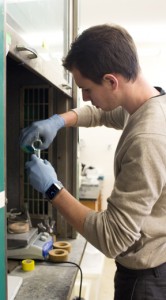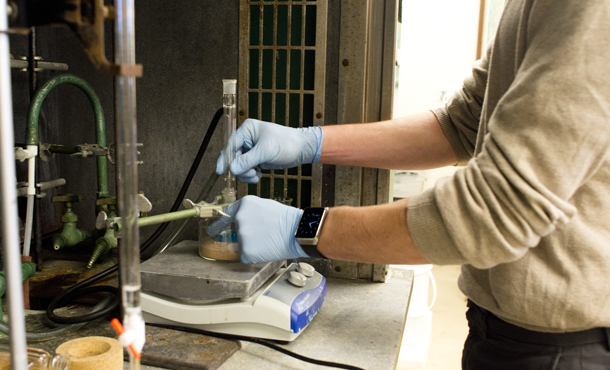Charlie Good synthesizes organic chemicals, websites, and contemporary band music – fusing the realms of creation and analysis.
“There’s definitely art in science,” says the third-year chemistry major at Eastern Mennonite University. Advanced lab work depends more on technique than step-by-step instruction. When recrystallizing a substance, “you just have to have the right touch.”

Good honed his scientific touch over the summer of 2014, spending 10 weeks alongside a graduate student at North Dakota State University. Their overall goal was to make organic chemistry more sustainable. Around 96% of current organic chemicals come from a petroleum base.
“That’s becoming a big issue for a number of reasons,” said Good. As sources of fossil fuels dwindle, the environment suffers and politicians clash. Seeking petroleum’s replacement, Good experimented with biomass carbohydrates to make chemical building blocks that could be used in polymers like plastic and nylon.
“The reality of the project, for me, was science doesn’t happen quickly,” said Good. Seven weeks into the program, he still had no results. He and his partner returned to the drawing board, put in 70-hour weeks at the lab, and wrangled a presentation from their data. Good ruefully describes the work as “demoralizing! I have no results, but I have to stay here for another 12 and a half hours!”
While in the short-term unsuccessful, their work represented another step towards revolutionizing organic chemistry. Even given the stress, Good recommends summer research programs for a glimpse into graduate school life and valuable research skills.
Upon returning to EMU, Good was invited by chemistry professor Matthew Siderhurst to contribute to an interdisciplinary project. In Hawaii, the “noni” fruit is revered as a cure-all for ailments, even cancer. Several recently published papers have started identifying the compounds in noni that may substantiate these claims. The method behind identifying noni’s chemical makeup, called running a standard, is Good’s next endeavor. He will create around 10 of the organic molecules suspected to be in noni and analyze them against the fruit. If the synthesized molecules match those found in noni, then those molecules are verifiably present at that stage of the fruit’s ripeness. Other collaborators, including student Alex Bender and Dee Weikle, assistant professor of computer science, will use statistical analysis to predict molecular changes throughout the fruit’s ripening.
As SGA‘s vice president for marketing, Good also marries creation and analysis in web design. He has worked with the director of student programs, Rachel Roth Sawatzky, to modernize how student clubs organize and attract members. While he has “dabbled in [visual] design work” with posters and flyers, his primary focus is the online content. Be it helping clubs code websites or creating Facebook pages, Good wants to give the SGA “some way to keep people engaged.”
Playing the tuba is one way Good himself stays engaged. “When I want an escape from science, I go to music,” he says. His flair for originality is present in music, as well: tuba has only been recently recognized as a solo instrument. He is also involved in a newly forming brass quintet on campus.
Good’s myriad talents are the product of imagination as much as practice. “At some level,” he says, “people stop being able to explain what they do in the lab. . . they have their own style.” This style, for him, generates innovative work in test tubes, for the ear, and on the web.
